Research
A Balancing Act
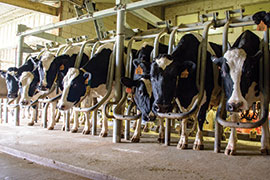
A high priority among cattle producers is to ensure that livestock are comfortable; however, a cow's inability to shed at the proper time may impact production performance. MAFES researcher, Dr. Trent Smith, recently discovered that cows that shed earlier in the season wean heavier calves. Read More
An Ample Diet
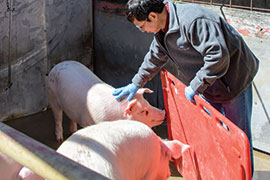
Pork, the most consumed meat in the world, is one of the most economical sources of animal protein for human consumption. Dr. Shengfa Liao, assistant professor in the Department of Animal and Dairy Sciences, grew up in a remote village in China when and where pork was a rare treat. As an Experiment Station researcher, he focuses on finding ways to enhance pork production by increasing feed efficiency for producers and improving animal welfare at the same time. Read More
Balanced Cows, Better Beef

The personality of livestock may seem secondary to productiveness, but research shows that the two may be connected. Cow temperament is correlated with how much money the cow brings in and how frequently it gets sick. Poor-tempered cattle are also known to produce less marbling and tougher beef. In an on-going study at the Brown Loam Research Station, researchers have studied the link between a cow's temperament and performance. Dr. Rhonda Vann, research professor in the Department of Animal and Dairy Sciences and the Experiment Station, pioneered work on this front. Read More
Do Cows Need to Shed?
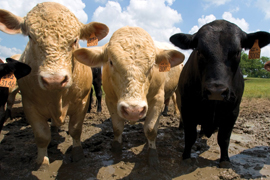
In the subtropical climate of the Southeast, cows that fail to shed in a timely manner tend to show more signs of heat stress than their slick-coated herd mates. MAFES researchers found that on average, cows that shed their hair coats by the end of May weaned heavier calves than cows that take longer to shed. Hair coat shedding is a moderately heritable trait and should respond to selective breeding. Producers seeking to reduce shedding-related heat stress in their herds should evaluate their cows in late May and consider culling cows that shed little or not at all.
Farm Finished

As more and more consumers opt for grass-fed beef, the product presents a unique market challenge-its uncooked meat turns brown faster than conventional, or grain-finished beef. That's why MAFES scientists sought to discover a natural way to preserve the bright red color longer. After testing a cherry extract and a rosemary and green tea extract applied with either pressurized or electrostatic sprayers, the team saw a marked decrease in browning on the steak when the cherry extract was applied with an electrostatic sprayer. The overall results translate to improved quality at a lower cost. Future work includes exploring different extracts and applications. Read More
Feeding Pigs More with Less
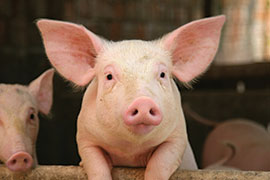
Feed eats up two thirds of the total operation costs for pork producers. While measures like using feed additives and alternative feedstuffs and refining facility management may slightly reduce those costs, MAFES scientists search for ways to dramatically improve feed efficiency. MSU researcher, Shengfa Liao, is assessing the fundamental molecular and cellular mechanisms by which nutrients regulate swine muscle development and growth. Liao studies how dietary nutrients, such as amino acids and minerals, impact the expression of genes related to the muscle growth of pigs. After determining the gene regulatory network that controls muscle protein biosynthesis and degradation, new nutritional strategies could be developed to activate the pertinent gene network to enhance the pig's ability to convert feed to muscle more efficiently, significantly reducing feed costs for pork producers.
For the Health of the Herds
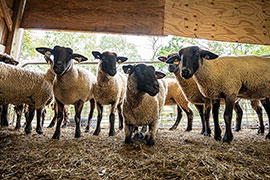
Dr. Leyla Rios, assistant extension and research professor in the Department of Animal Dairy Sciences and MAFES scientist and Lindsey Dearborn, master's student in the Department of Animal Dairy Sciences, are investigating parasite loads across five goat and five sheep flocks in Mississippi to evaluate indicators of parasitism. Starting in Fall 2021, the researchers aimed to help farmers identify better ways to sustainably manage parasite control while avoiding the increase of parasite resistance. Continuing into Spring 2022, scientists hope to provide quantifiable data that lets them know which indicators correlate best with actual parasitic loads, so they know which animals need to be treated. Read More
Forage Flyover
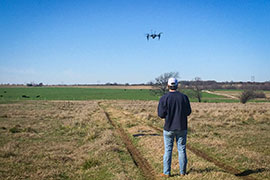
Dr. Garrett Street, associate professor in the Department of Wildlife, Fisheries, and Aquaculture and co-director of the Quantitative Ecology and Spatial Technologies Laboratory, Dr. Joby Czarnecki, an associate research professor in the MSU Geosystems Research Institute and MAFES scientist, and scientists in MAFES and the MSU Forest and Wildlife Research Center have collaborated to focus on using UAVs and accelerometers to better understand forages. The researchers aim to learn how forage quality and availability influence the long-term body quality and behavior of grazing animals, such as cattle, while remaining cost-effective. The team developed mathematical models that allow researchers to think about cattle behavior and movements affecting calorie intake and expenditure. Since 2019, they have been able to create models predicting forage characteristics like total fiber, crude protein, and nitrogen, and they produced maps giving fine-scale and accurate information about different aspects of forage quality that affect grazing systems. Researchers aim to have these models be universally applicable. By using drones and boots-on-the-ground methods of analyzing a landscape, the researchers can bridge the gap of information that would otherwise occur if using only one method. The products produced from this research will allow cattle producers to know how much forage is available in a pasture as well as the nutritional quality of that forage, decreasing the likelihood of overgrazing. Read More
Go with the Flow

Two MAFES scientists, Dr. Caleb Lemley and Dr. Derris Devost-Burnett, are leading a team of researchers who are using biophotonics to study how maternal nutrient restriction affects calves. Lemley, an animal and dairy science assistant professor, focuses on the mother while Burnett focuses on the calves. The researchers evaluated the placentas, fetuses, and offspring of Angus and Brahman heifers sired by a Hereford bull. The team evaluated the placenta because it connects the mother to the fetus, studying how blood flow, in particular, can impact how nutrients the mother intakes reach the fetus. They sought to learn how maternal nutrient restriction affected the placenta's development. Lemley said understanding alterations of placental development during pregnancy will help producers to maximize fetal development in-utero, possibly decreasing the instances of calf morbidity and mortality. Burnett said, "While Lemley focuses on the maternal environment itself, I evaluate how that environment affects the growth of muscle and fat in the offspring." Thus far, the researchers have observed birth weight reduction and the development of less muscle fibers in offspring that were nutrient-restricted in-utero. Burnett said, "We hope research like this allows us to provide producers with data-based information that helps move the industry forward." Read more
Healthy Mom, Happy Calf

Melatonin is a hormone our body naturally produces. Melatonin as a supplement is considered an antioxidant. While many people may take melatonin for a good night's rest, researchers in the Mississippi Agricultural and Forestry Experiment Station are evaluating how melatonin supplements might help pregnant Holstein heifers give birth to healthier calves. Dr. Caleb Lemley, assistant professor in the Department of Animal and Dairy Sciences, along with two graduate and two undergraduate researchers, studied how melatonin supplementation affected blood flow between dam and calf during gestation. Read More
Improved Grazing Systems for Cattle and Wildlife
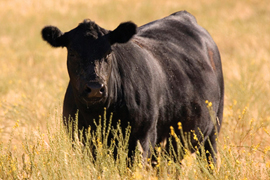
MAFES scientists are evaluating cattle performance and environmental impacts of grazing based on native, warm-season grasses. These grasses once dominated the landscape but have been eliminated by conversion to agriculture and exotic forage grasses. Native grasses produce high biomass that is palatable and nutritious for livestock. These grasses also provide superior habitat for a variety of wildlife species, including bees and butterflies.
Increasing Fertility in Farm Animals

High fertility is critical for efficient and profitable production of livestock. Obtaining viable offspring depends on quality and ability of sperm and egg to generate a developmentally competent embryo, fetus and offspring. Using innovative research techniques and cutting edge genomics approaches, the advanced research group led by Erdoğan Memili has identified biomolecular markers and mechanisms for determining the quality of sperm, egg and embryos. Through extensive collaborations with researchers in universities, research institutions, and industry around the world, the group has identified important new DNA, RNA and protein biomarkers associated with bull fertility. The world-class research is linked to education and provides valuable research experiences for undergraduate students, graduate students, and postdoctoral and international scientists. In addition to fertility, the research team also investigates genomics and epigenomics of other economically important traits within the realm of animal systems physiology. The research results are significant because they help advance fundamental science of animals and animal biotechnology. Furthermore, because of the similarities in genetics and physiology among the mammals, the research findings in farm animals are also applicable to other mammals including humans. Listen to what our students have to say: Undergraduate students | Graduate students | International students
Luminating Infections in Pregnant Mares
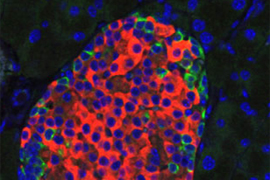
Infections are the leading cause of abortion, stillbirth and preterm delivery in mares. MAFES scientists have developed a new approach to understanding the infection process in pregnant mares by using biophotonic imaging and modified bacteria with luminescent characteristics. In other words, the technique allows researchers to capture real-time pictures of glowing bacteria as they spread through a mare's body. The method allows scientists to track pathogens in a minimally invasive procedure.
Making artificial insemination of cows more effective
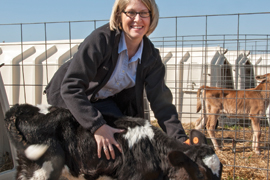
Animal scientist Jamie Larson, who specializes in cattle reproductive physiology, works with beef and dairy cattle to make artificial insemination more effective. Larson is experimenting with hormone treatments to determine if cows' estrous cycles can be more closely synchronized, allowing them to be bred at about the same time. Cattle production would be more efficient if calves are about the same age and size. Scientists perform repetitive ultrasound at the Beef Unit to determine the effectiveness of their hormone protocol. Larson also works with fellow reproductive physiologist Caleb Lemley at the Bearden Dairy Research Center, monitoring cows to determine whether conditions in early gestation affect the health and future performance of calves. Researchers monitor cows 90 days before they give birth and follow the calves throughout their lives. Their goal is to identify ways to improve conditions in the womb to ultimately enhance calf health.
Marbling trumps thickness in steaks

Animal scientist Trent Smith examines the importance of marbling, streaks of fat within lean sections of meat. Marbling adds quality and flavor and increases the value of a cut of meat. At MSU's Leveck Animal Research Center or South Farm, Smith studies two groups of 30 purebred Angus cattle. One group has the genes that influence marbling, while the other does not. His goal is to evaluate the cattle's performance and analyze the impact of the marbling genes. A MAFES survey found that most consumers cited marbling as the most important attribute of rib-eye steak. Even if consumers were not willing to pay more for thick cuts, most said they would pay more for well-marbled steaks.
Marked for Life

Drs. Erdogan Memili, professor, and Thu Dinh, associate professor, both in the Department of Animal and Dairy Sciences and MAFES scientists, along with their team of students and researchers, aimed to improve predictions and knowledge around bull fertility. Historically, predicting fertility in bulls is unreliable and tedious, yet it is a considerable influence in the agricultural industry and in the world of reproductive technology, including human applications. Using a biomarker associated with bull fertility, Protamine 1 (PRM1), the team was able to evaluate semen quality and predict bull fertility. The team added Halmox and Toluidine blue staining methods and found that sperm from high fertility bulls had consistently greater levels of PRM1. This result provides a sperm that is stronger and can result in a more successful insemination process. Now, the team has expanded the research to identify additional sperm fertility biomarkers using transcriptomics, metabolomics, and lipidomics. The goal with these added biomarkers is to identify as many markers as possible that indicate fertility and economically valuable traits. Read More
MSU Researchers Ask What Steak Eaters Crave
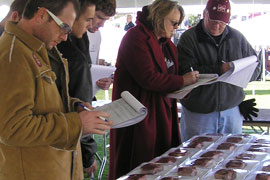
MAFES researchers recently conducted a study to gauge the public's willingness to pay extra for thicker, heartier steaks.
The study found that most consumers did not highly value thickness. Only 23 percent of consumers listed thickness as the most important factor of a rib eye, making it only the third most important attribute. Thirty percent cited marbling as the most important attribute of rib eye, making it the most important factor tested. Thickness only defeated marbling for first place with the sirloin steaks.
The study found that even if consumers are not willing to pay more for thickness, most of them are willing to pay more for characteristics such as color and marbling.
Preserving the Catch

The quality of catfish decreases dramatically after a mere 72 hours of sitting on grocery store shelves. With catfish bringing in $226 million in production value for the state, MAFES researchers are diligently searching for ways to better preserve our catfish. In particular, this study is interested in the effects of chitosan, a substance derived from shellfish and crustaceans. The scientists applied chitosan to the catfish to see if it increased its shelf life. Though the study has yet to complete all of its trials, there was a significant increase in catfish shelf life once chitosan was applied. Read More
Protecting Pork
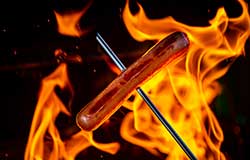
A recent study by the USDA Food Safety and Inspection Service found nearly a 10 percent increase in Salmonella incidence rate in pork trimmings. Because of this, MSU researchers sought to provide the pork industry with a natural, low-cost approach to reducing Salmonella and making meat products safer. Specifically, this involved introducing increased safeguards in the post-harvest environment. After rigorous testing, researchers saw that applying vinegar to the meat at a high temperature for a specific period of time kills Salmonella bacteria. This method offers a low-cost, natural way to keep eliminate the pathogen. Read More
Research Reveals Value of Selecting Calm Cattle

Recent research has demonstrated the value of cattle with calm temperaments and the price producers pay for keeping wilder animals in their herds. A 5-year MAFES study found that cows with poor temperaments could affect an entire herd and reduce producers’ bottom lines.
Findings from this research led scientists to conclude that producers should cull bad-tempered cows from their herds.
Researchers measured how a trio of cows behaved while enclosed in a 12-by-12-foot pen. They also studied the behavior of a single cow held in a chute similar to the ones used to hold bulls before they are released at rodeos.
In both cases, the cows’ behavior was measured after humans approached them. The research used laser technology to gauge how fast a cow traveled 6 feet after being released from a chute. For each part of the experiment, the cows were scored on a 5-point scale. A score of 1 described cows that were nonaggressive, docile, slow walking, easily approachable and not excited by humans. A score of 5 described cows that were very aggressive, excitable and out of control.
The pen scores and chute scores were nearly identical. Higher-scoring cows almost always ran out of the chutes at accelerated speeds.
The research found that anxious, aggressive cows — those with a pen score of 4 or 5 — present a host of problems. They become sick more often, have more difficulty gaining weight and damage farm equipment.
According to the study, cattle with high pen scores typically incur higher medical expenses than lower-scoring cattle. In addition, ill-tempered cattle typically bring in $5 or $6 less per hundred pounds of body weight than do calmer animals.
Researchers Make 'Elusieve' Dreams Happen
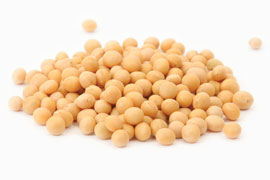
Ground corn flour, soybean meal and distillers dried grains with solubles (DDGS) — a by-product from ethanol production — comprise more than 70 percent of swine and poultry diets. While these ingredients are important for livestock nutrition, they are high in fiber, which is not easily digested by swine and poultry. Feed producers needed a system to remove the fiber while maintaining vital nutrients.
MAFES scientists developed a process called "Elusieve" that uses a combination of sieving and air classification to separate fiber from feeds. This technique sifts particles into four sizes and then blows them with air to remove fiber. They found that fiber separation increases starch content of ground corn flour by 3 percent and increases protein contents of DDGS and soybean meal.
Safer Horse Transportation

There has been little research to measure the heat conditions in horse trailers during transport. MAFES scientists recently measured several temperature variables in a fully enclosed four-horse, ant-load trailer with and without animals. Scientists found that trailer temperatures during transport exceeded those recommended for animal housing, although the thermal environment was affected by vehicle speed, vent configuration and presence of animals. They found that temperature increased significantly in transport during relatively mild weather, which indicates that horses could suffer from heat stress during warmer weather. These results show the importance of closely monitoring heat conditions in trailers used to transport horses.
Steeds Steady Students
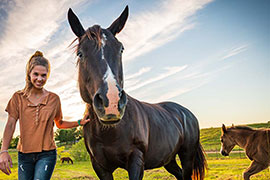
Though equine-assisted therapy is largely unstudied in the broader scientific world, researchers at MAFES are striving to understand the impact that horses can have on a person's emotional health. The study draws on the researchers' past experience with studying equine therapy in treatment for addiction in order to assess the confidence and knowledge of student volunteers. This research frames horses as facilitators of emotional security. By forming bonds with the volunteers, they serve to break human-made emotional barriers and allow for students to bolster their confidence and self-worth. Read More
Understanding the Complexities of Reproduction
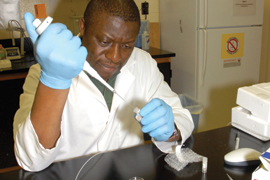
MAFES reproductive biologist Jean Feugang is trying to find out why some pregnancies are successful and others are not. Feugang, along with fellow scientists Peter Ryan and Scott Willard, are studying the reproductive stage that remains one of the most mysterious-the gap between sperm and egg development and embryo development. Specifically, the team hopes to understand what factors make one sperm successful while others fail and why some eggs take while others do not. Their research can provide invaluable insight into biological and cellular processes associated with sperm and egg behavior and interactions before early embryo development. They use nanotechnology to study reproductive issues at the most microscopic level. Using quantum dots-nanoparticles that are absorbed into sperm cells-they can track the cells' movement along the reproductive tract. Much like putting a tiny camera into the body, this process shows researchers what is happening, when, and where in real time. The scientists are using swine for the study; however, their research has applications to all mammals, including humans. Developing noninvasive monitoring techniques for use after artificial insemination has the potential to improve breeding success rates. Using quantum-dot imaging in reproductive studies is a new approach, and MAFES scientists are laying the groundwork for future research in this area.

